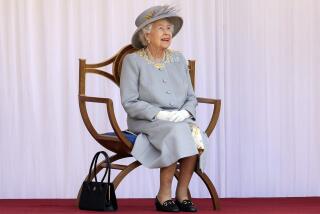Stylish Dining Aboard the QE2
- Share via
On a recent cool, misty Sunday we went to the Port of Los Angeles for our annual visit to Cunard’s Queen Elizabeth 2.
Normally the yearly call marks the end of the first segment and the beginning of the second of an around-the-world cruise, but this time the charismatic but beleaguered QE2 was outbound for the Pacific Ocean. At the end of this month, she is scheduled to tie up in Yokohama to serve for two months as a hotel, restaurant and major sightseeing attraction during that city’s 1989 exposition.
Executive chef Franz Sladek expects up to 4,000 Japanese visitors a day for lunch, and hotel manager John Duffy will face 1,870 guests every night, with a full turnaround in rooms daily.
With the Japanese enthusiasm for Western brand-name luxuries--from Beverly Hills to Fifth Avenue--it’s hardly surprising that this famous ship carries so much cachet.
An Elegant Ship
The QE2 is the most elegant ship afloat, provided that one can dine in the Princess Grill or the Queen’s Grill. But even a first-class booking, contrary to what many passengers expect, has never guaranteed a grill room table.
Until this year the QE2 distinguished itself among the 150 or so cruise ships of the world by selling both first-class and transatlantic-class (read “tourist class”) tickets on transatlantic crossings.
In the 1989 QE2 brochure, however, the references to class have been quietly dropped, with the vessel continuing to adhere to restaurant assignments based on cabin location. And while all the restaurants ostensibly carry the same menu, the food seems better in the rarefied atmosphere of the Princess and Queen’s grills.
Waiters are more polished, they encourage passengers to order special dishes not on the menu and they dish out generous dollops of caviar on request.
In 1985 in his “Liners to the Sun” about the transition from ocean liners to cruise ships, the eminent ship historian/lecturer John Maxtone-Graham suggested that the QE2 “embraces transatlantic, first, and what I shall call grill class . . . to all intents and purposes, a separate class.”
How Assignments Work
Here’s how it works: Assigned to the chic ebony-and-champagne elegance of the Queen’s Grill, which has its own galley and its own handsome lounge, are the occupants of the most expensive luxury suites and cabins. They cost from $700 a day per person, double occupancy, on a crossing, including a one-way British Airways ticket between London and 57 North American gateways.
Passengers in category D ($650 to $898 a day) dine in the burgundy velvet surroundings of the Princess Grill. Cabin categories E through H (from $500 a day) are assigned to the spacious Columbia Grill and the remaining passengers (from $265 a day) are seated in the large Mauretania dining room. All the cabin categories are matched with their respective restaurant assignments in the printed materials from Cunard.
While there are no physical barriers to keep passengers confined to certain areas, a sign at the door to the Queen’s Grill lounge points out that the area is limited to passengers assigned to the Grill Room restaurants.
Stairway access to the hushed grandeur of the deluxe penthouse suites is from that same lounge, so that passengers in the Queen’s Grill hardly ever need to leave that sheltered enclave. Even the theater balcony is just steps away, if they wish to see a film or concert.
Passenger Patterns
When we made a crossing aboard the QE2 in 1987 we noticed that the passengers tended to sort themselves into classes, particularly the British. In what had been the tourist-class lounge, now the Grand Lounge, the great majority of passengers were gathered much of the day chatting, reading, knitting, sipping tea and munching on biscuits. The former first-class lounge, now the Queen’s Room, was often almost empty, those passengers presumably enjoying the privacy of their larger, more luxurious cabins, the fitness regime of the Golden Door Spa at Sea or a glass of champagne in the Queen’s Grill lounge.
We noticed a similar division on the new Royal Viking Sun on a crossing from London to Miami. The occupants of the more expensive quarters gravitated at teatime toward a quiet upper-forward lounge called the Stella Polaris, adjacent to the suites and penthouses. The others were drawn to the big Norway Lounge, four decks below and nearer the standard cabins, where an informal afternoon tea is served during bingo.
A crossing has a very different rhythm from a cruise--the ship becomes your whole world, with no distractions from ports of call. Lectures, films, concerts and games attract more passengers than they do on cruises. People strike up random, sometimes intense, friendships.
The North Atlantic weather is rarely ideal for sunbathing, and sometimes so wet or cool that passengers don’t spend much time on deck. The southerly routes, such as those from Florida or Puerto Rico to Spain or Portugal, usually deliver more sunshine.
Crossings Start in June
QE2’s 18 crossings for 1989 begin in June and are scheduled through Nov. 26 at regular intervals. Certain “matched transatlantic sailings” offer low-priced round-trip fares on specified sailings and returns for $1,505.
Special fares aboard the all first-class, 33-seat Boeing 727s of MGM Grand Air between New York City and California ($695) and British Airways’ Concorde, between New York City and London ($995), also are available to QE2 passengers when reservations are made at the time of booking.
On the return from Yokohama, beginning June 9 in Honolulu, QE2 hosts a 19-day music festival at sea organized by Exprinter Cruises and starring more than a dozen renowned concert artists, from violinist Ruggiero Ricci to baritone Robert Merrill and the Trio West of the Los Angeles Philharmonic.
Segments of the 19-day cruise, which ends in New York June 28, are available beginning at $1,100 per person, double occupancy.
California passengers have an unusual opportunity for a transatlantic crossing with a Los Angeles departure June 15, arriving in Ft. Lauderdale June 26, New York June 28, Southampton July 3 and Cherbourg July 4. To the crossing fare, add a minimum of $2,025 for the Los Angeles-New York leg.
More to Read
Sign up for The Wild
We’ll help you find the best places to hike, bike and run, as well as the perfect silent spots for meditation and yoga.
You may occasionally receive promotional content from the Los Angeles Times.






